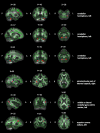White matter microstructural and Compulsive Sexual Behaviors Disorder - Diffusion Tensor Imaging study
- PMID: 33570504
- PMCID: PMC8969848
- DOI: 10.1556/2006.2021.00002
White matter microstructural and Compulsive Sexual Behaviors Disorder - Diffusion Tensor Imaging study
Abstract
Background and aims: Even though the Compulsive Sexual Behavior Disorder (CSBD) was added to the ICD-11 under the impulse control category in 2019, its neural mechanisms are still debated. Researchers have noted its similarity both to addiction and to Obssesive-Compulsive Disorder (OCD). The aim of our study was to address this question by investigating the pattern of anatomical brain abnormalities among CSBD patients.
Methods: Reviewing 39 publications on Diffusion Tensor Imaging (DTI) we have identified main abnormalities specific for addictions and OCD. Than we have collected DTI data from 36 heterosexual males diagnosed with CSBD and 31 matched healthy controls. These results were then compared to the addiction and OCD patterns.
Results: Compared to controls, CSBD individuals showed significant fractional anisotropy (FA) reduction in the superior corona radiata tract, the internal capsule tract, cerebellar tracts and occipital gyrus white matter. Interestingly, all these regions were also identified in previous studies as shared DTI correlates in both OCD and addiction.
Discussion and conclusions: Results of our study suggest that CSBD shares similar pattern of abnormalities with both OCD and addiction. As one of the first DTI study comparing structural brain differences between CSBD, addictions and OCD, although it reveals new aspects of CSBD, it is insufficient to determine whether CSBD resembles more an addiction or OCD. Further research, especially comparing directly individuals with all three disorders may provide more conclusive results.
Keywords: Compulsive Sexual Behaviors Disorder; Diffusion Tensor Imaging; Obssesive-Compulsive Disorder; addictions; hypersexuality; white matter microstructure.
Conflict of interest statement
The authors declare no conflicts of interest with respect to the content of this manuscript.
Figures



Similar articles
-
Microstructural white-matter abnormalities and their relationship with cognitive dysfunction in obsessive-compulsive disorder.Brain Behav. 2016 Feb 5;6(3):e00442. doi: 10.1002/brb3.442. eCollection 2016 Mar. Brain Behav. 2016. PMID: 27099803 Free PMC article.
-
Compulsive sexual behavior disorder in obsessive-compulsive disorder: Prevalence and associated comorbidity.J Behav Addict. 2019 Jun 1;8(2):242-248. doi: 10.1556/2006.8.2019.23. Epub 2019 May 13. J Behav Addict. 2019. PMID: 31079471 Free PMC article.
-
Microstructural white matter abnormalities in obsessive-compulsive disorder: A coordinate-based meta-analysis of diffusion tensor imaging studies.Asian J Psychiatr. 2021 Jan;55:102467. doi: 10.1016/j.ajp.2020.102467. Epub 2020 Nov 4. Asian J Psychiatr. 2021. PMID: 33186822
-
Diffusion tensor imaging (DTI) studies in patients with obsessive-compulsive disorder (OCD): a review.J Psychiatr Res. 2014 Jul;54:26-35. doi: 10.1016/j.jpsychires.2014.03.006. Epub 2014 Mar 19. J Psychiatr Res. 2014. PMID: 24694669 Review.
-
Microstructural white matter abnormalities in pediatric and adult obsessive-compulsive disorder: A systematic review and meta-analysis.Brain Behav. 2021 Feb;11(2):e01975. doi: 10.1002/brb3.1975. Epub 2020 Dec 3. Brain Behav. 2021. PMID: 33270358 Free PMC article.
Cited by
-
Another failure of the latent disease model? The case of compulsive sexual behavior disorder •J Behav Addict. 2022 Sep 16;11(3):615-619. doi: 10.1556/2006.2022.00069. Print 2022 Sep 26. J Behav Addict. 2022. PMID: 36112489 Free PMC article.
-
Evaluation and treatment of compulsive sexual behavior: current limitations and potential strategies.Front Psychiatry. 2025 Jul 3;16:1621136. doi: 10.3389/fpsyt.2025.1621136. eCollection 2025. Front Psychiatry. 2025. PMID: 40677854 Free PMC article. Review.
-
Exploring the role of the amygdala in Compulsive Sexual Behavior Disorder via a parcellation pipeline based on Recurrence Quantification Analysis.J Behav Addict. 2025 Mar 10;14(1):204-219. doi: 10.1556/2006.2025.00014. Print 2025 Mar 28. J Behav Addict. 2025. PMID: 40063093 Free PMC article.
References
-
- Babor, T. F., de la Fuente, R. J., Saunders, J., & Grant, M, (1989). AUDIT. The alcohol use disorders identyfication test. Guidelines for use in primary Health care. Genewa: World Health Organization.
-
- Benedetti, F., Giacosa, C., Radaelli, D., Poletti, S., Pozzi, E., Dallaspezia, S., et al. (2013). Widespread changes of white matter microstructure in obsessive–compulsive disorder: Effect of drug status. European Neuropsychopharmacology, 23(7), 581–593. 10.1016/j.euroneuro.2012.07.002. - DOI - PubMed
Publication types
MeSH terms
LinkOut - more resources
Full Text Sources
Other Literature Sources
Medical
Research Materials

